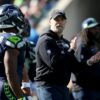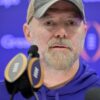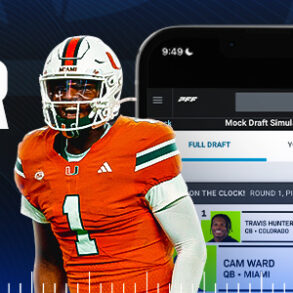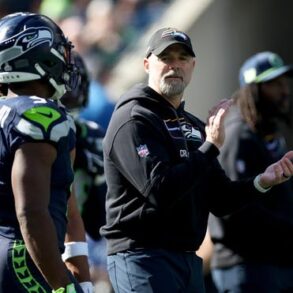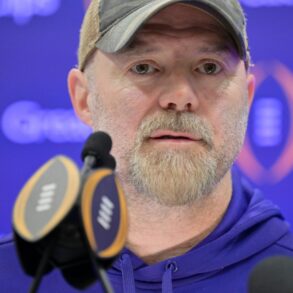Bronco Mendenhall has plenty of work to do at Utah State.
The Aggies are coming off their worst 12-game season since 2016 and they have had one of the worst defenses in college football for multiple seasons now, a defense three different coordinators couldn’t fix.
They’ve replaced about a third of the roster this winter alone, adding more than 40 players to the 2025 team. Establishing a strong NIL program remains a constant battle and with revenue sharing on the horizon — Utah State athletic director Diana Sabau recently said the Aggies will not be participating in revenue sharing in 2025 as a member of the Mountain West Conference, but the day is coming — the finances of college football will only get more difficult.
Mendenhall has to win games, and quickly. Sabau hasn’t been shy about wanting USU to contend for conference titles and that .500 seasons are not acceptable.
To win the needed amount, Mendenhall — and defensive coordinator Nick Howell — has to fix the Aggies’ defense. To do that, Mendenhall has to bring in new — i.e. better — overall talent and he has to find a way to retain said talent without the benefit of having the deep pockets of many power conference programs and even some Group of Five programs.
It is a daunting task all around, even if Utah State has been — for more than a decade now — one of the better overall programs at the Group of Five level, with 11 bowl games played in in the last 15 seasons and four 10-plus win seasons over that same stretch.
There are more issues beyond all of that, too.
There is, for instance, the desperate need to establish a culture at Utah State that appeases the demands of the U.S. Department of Justice.
But talking just about football, nothing is more important for Mendenhall right now than finding NFL talent.
The drought
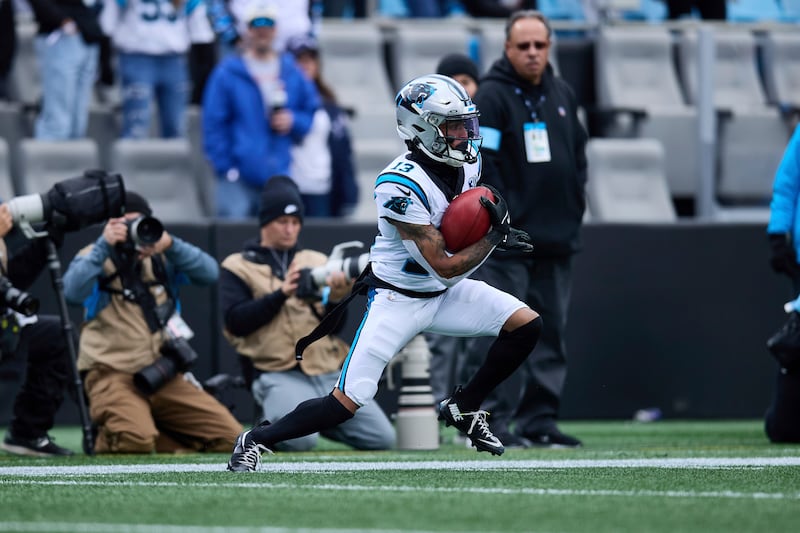
The Aggies, for the most part, haven’t produced NFL talent for a while, with wide receiver Jalen Royals being basically the lone exception of the Blake Anderson era and he’s not in the NFL yet.
The last Aggie taken in the NFL draft was Jordan Love, a first-round pick by the Green Bay Packers in 2020. Royals will end that drought — he is currently projected as a second- or third-round pick, though his showing during Senior Bowl practices last week had multiple draftniks postulating that he could potentially wind up being a late first-round selection.
But two draft picks over a six-year span isn’t great, and for Utah State in particular.
During the 2010s, 12 players who played for Utah State at some point in their collegiate careers were drafted into the NFL:
- Maurice Alexander (No. 110 pick in 2014).
- Will Davis (No. 93 pick in 2013).
- Kyler Fackrell (No. 88 pick in 2016).
- Nevin Lawson (No. 133 in 2014).
- Curtis Marsh (No. 90 pick in 2011).
- Devante Mays (No. 238 in 2017).
- Michael Smith (No. 212 in 2012).
- Darwin Thompson (No. 214 in 2019).
- Robert Turbin (No. 106 in 2012).
- Nick Vigil (No. 87 in 2016).
- Bobby Wagner (No. 47 in 2012).
- Kerwynn Williams (No. 230 in 2013).
Love is the only Aggie who has been drafted during the 2020s right now, and even after Royals is taken, two players in more than half a decade pales in comparison to what the Aggies produced in the 2010s.
It is more than just draft picks, though.
Twelve Aggies were taken in the NFL draft in the 2010s, but during that same time period another 15 former Utah State players played at least a year in the league after going undrafted.
The number of undrafted Aggies from the 2020s to play at least a year in the NFL is four.
That Anderson didn’t find — or really develop — NFL talent isn’t too surprising, and the drought coincides with the Anderson era at Utah State.
Before he took over at Arkansas State in 2014, the Red Wolves had nine players drafted over a 10-year period. Arkansas State hasn’t had a player drafted since Ryan Carrethers in 2014.
During Anderson’s seven seasons in Jonesboro, not a single Red Wolf was drafted into the NFL.
Anderson won a lot of games — at Arkansas State and Utah State — and he peaked in 2021 with an Aggie team that eked out close win after close win and eventually won the first-ever Mountain West title in program history.
But he didn’t really find or develop much NFL talent. Royals, again, being the big exception.
Deven Thompkins (now with the Carolina Panthers) was brought to Utah State by Matt Wells and played for Gary Andersen as well as Blake Anderson. Thompkins did flourish under Anderson (and wide receiver coach Kyle Cefalo), to be fair, though.
Cam Lampkin (who was with the Los Angeles Rams for four games this year), meanwhile, was a Gary Andersen recruit who transferred to Washington State in 2022.
There have been players at Utah State during the Blake Anderson era who may have ended up in the pros if they had stayed at Utah State.
Defensive end Byron Vaughns and wide receiver Micah Davis stand out among a group, but there is no guarantee that would’ve happened if they had not transferred to Baylor and Ole Miss, respectively.
Playing hypotheticals at that level is usually reserved for fans of SEC teams.
The simple reality is, Utah State used to regularly put players into the NFL via the draft and undrafted free agency, but the Aggie pipeline to the pros has slowed down considerably.
The solution

There is real reason to believe that Mendenhall will be able to bring more NFL-caliber talent to Utah State.
Over the course of his coaching career, Mendenhall has produced upwards of 115 NFL players (that means players who’ve signed contracts with NFL teams).
Spread across his 18 years as a collegiate head coach, and Mendenhall has averaged about six future pros a year on his teams.
It isn’t reasonable to always expect that level of talent at USU — objectively speaking BYU and Virginia are more monied programs in larger conferences and easier programs to lure talent to — but even a third of that NFL talent would be far more than USU has produced this decade.
Mendenhall isn’t shy in his belief that he knows how to find elite talent. Moreover, he is confident he can find the requisite talent in places other people aren’t looking or aren’t looking that hard, which Utah State has always needed to do, be it at the high school level, junior college level or in the transfer portal.
“I’m confident. I’m clear. Certainly we are really well thought out about what our measurables as well as intangibles look like for someone that is going to fit in our program, and quite frankly I really don’t care who else wants them. That is not an overstatement. We are really confident in our processes,” Mendenhall told KSL Sports’ Scott Garrard and Hans Olsen last month.
Most of that confidence stems from Mendenhall’s own track record. He’s proven able to find and develop NFL talent at every stop he’s been at.
“The best predictor of future performance is past performance,” Mendenhall said.
Whether he’ll be able to keep that talent in Logan is a different matter. Mendenhall has taken a unique approach to NIL. He explained that in his program that players will earn their compensation over time.
“I have chosen to approach NIL is with a very simple not given mentality, and that means that players by performance, players by marks in the classroom, players by the way they train in the weight room, players by how their character is, that is what qualifies them for a chance to benefit from their name, image and likeness,” he said.
More important than how he approaches NIL is that Utah State actually has the funds needed to keep players around, at least until such time as Mendenhall has enough depth of talent to withstand transfer portal departures and not have to rebuild on a yearly basis (which Anderson had to do for most of his USU tenure).
Mendenhall is working on that, too.
“As a football program, we are committed to ensuring that our student-athletes thrive both on the field and off it, with a strong focus on character development,” Mendenhall said in a statement two weeks ago as part of a university-wide effort to raise more NIL funds. “The growth of NIL and our Blue A Collective is crucial to our success and the ability to retain the right players that fit our culture and reflect the hardworking, blue-collar values of this community.
“By designing and emphasizing our NIL program and Blue A Collective thoughtfully, we can provide our student-athletes with the resources they need to succeed not only on the field but in the classroom and in their personal lives, as well. This initiative also allows them to give back to the people and community that support us. A successful NIL program uplifts everyone—our athletes, our fans, and the entire university—ensuring that we all rise together.”
Keeping players in Logan is primarily a secondary issue, though. The first and most pressing need right now for Mendenhall is to find and put more future pros on Utah State’s roster.
Prove Utah State is once again able to put players in the pros on the regular and most of the other issues — the winning at a high clip, the turnaround of the Aggies’ defense, even player retention — should fall into place.
This post was originally published on this site be sure to check out more of their content.



